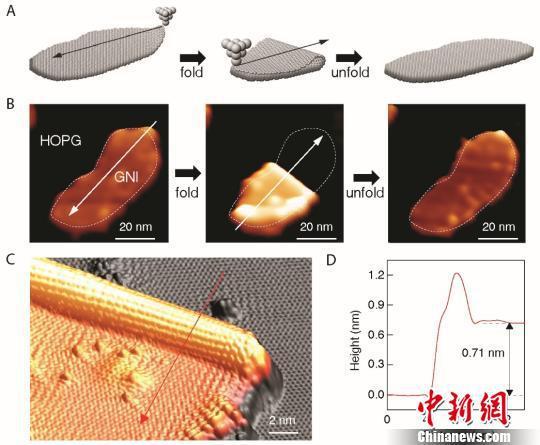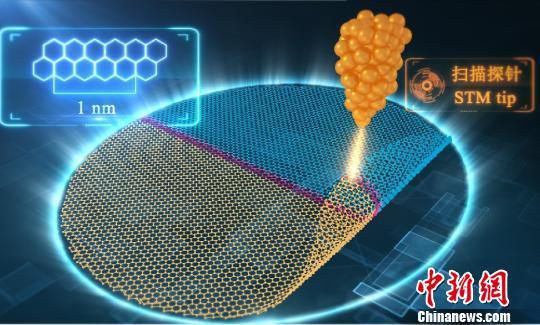Chinese scientists have achieved atomically precise and controllable folding of graphene nanostructures

Construction of three-dimensional graphene nanostructures by atomically accurate graphene origami. Chinese Academy of Sciences/Photo
An international first! Chinese scientists have achieved atomically precise and controllable folding of graphene nanostructures
Beijing, September 6 (Reporter Sun Zifa) The Chinese Academy of Sciences announced on the 6th that a research team led by Academician Gao Hongjun of the Institute of Physics of the Academy recently achieved the first atomic-level precise control of graphene nanostructure folding in the world, which is currently the world's smallest size, customizable graphene "origami".
The construction of a rotating stacking double layer graphene with precise folding direction control and continuous Angle adjustment. Chinese Academy of Sciences/Photo
This important research achievement completed by Chinese scientists in the field of graphene was published by the authoritative international academic journal Science in the early morning of the same day, Beijing time.
It is understood that the exploration of new low-dimensional carbon nanomaterials and their novel physical properties has been one of the cutting-edge scientific issues in today's science and technology field, and the two-dimensional graphene lattice structure is considered to be the parent material of many other carbon nanostructures. Theoretical predictions have found that at the atomic scale, nanostructures with novel electronic properties can be constructed by bending and folding graphene, but precisely folding graphene at the single atomic scale, especially in a specific direction according to special needs, is extremely challenging.

Construction of one-dimensional carbon nanoboundary structures with precise tuning of chiral structures and electronic states. Chinese Academy of Sciences/Photo
Inspired by the art of origami, folding manipulation is often cleverly used in many frontiers of science and technology. Recently, Dr. Chen Hui and others from Academician Gao Hongjun's research team have achieved atomically accurate controllable folding of graphene nanostructures for the first time in the world through scientific research, and constructed a new quasi-three-dimensional graphene nanostructure, which is composed of two-dimensional rotating stacking double-layer graphene nanostructures and one-dimensional carbon nanotube-like structures.
The folded bicrystalline graphite nanosheets accurately construct the heterojunction structure. Chinese Academy of Sciences/Photo
Through the scanning probe manipulation technology, the research team has achieved five breakthroughs: first, the atomic-level accurate folding and unfolding of graphene nanostructures; Second, the same graphene structure folds repeatedly in any direction; Third, the double-layer graphene nanostructures with rotating stacking Angle accurately adjustable; Fourth, the construction of quasi-one-dimensional carbon nanotubes nanostructures; The fifth is the controllable folding of the nanostructures of bicrystalline stonemene and the construction of heterojunctions. The research team also found that the quasi-one-dimensional nanotube heterojunctions obtained by graphene "nanorigami" have different band arrangements.
Scanning probe effect diagram. Chinese Academy of Sciences/Photo
Chinese scientists have achieved the world's first atomically accurate, on-demand "origami" of the world's smallest graphene, It can also be used to construct folding nanostructures and heterojunction quantum devices of other new two-dimensional atomic crystal materials, to construct complex folding structures and heterojunction quantum devices of various two-dimensional atomic crystal materials, and to study the physical properties of folded structures cleanly in situ, so as to prepare functional nanostructures and quantum devices and study their novel physical phenomena. At the same time, it has important scientific significance for the construction of new quantum materials and quantum devices (machines) and their applications. (over)

